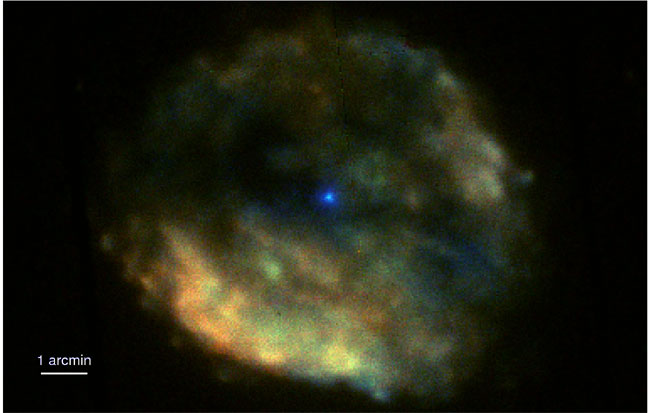Mystery Object Found in Supernova's Heart

Embedded in the heart of a supernova remnant 10,000 light-years away is a stellar object the likes of which astronomers have never seen before in our galaxy.
At first glance, the object looks like a densely packed stellar corpse known as a neutron star surrounded by a bubble of ejected stellar material, exactly what would be expected in the wake of a supernova explosion.
However, a closer 24.5-hour examination with the European Space Agency's XMM Newton X-ray satellite reveals that the energetic X-ray emissions of the blue, point-like object cycles every 6.7 hours-tens of thousands of times longer than expected for a freshly created neutron star.
It is behavior that's more commonly seen in neutron stars that have been around for several million years, researchers say.
"The behavior we see is especially puzzling in view of its young age, less than 2,000 years," said study leader Andrea De Luca of the Istituto Nazionale di Astrofisica (INAF) in Milan. "For years we have had a sense that the object is different, but we never knew how different until now," De Luca said.
The finding is detailed in the July 7 issue of the journal Science.
Novel stage?
Get the Space.com Newsletter
Breaking space news, the latest updates on rocket launches, skywatching events and more!
Called 1E161348-5055, or 1E for short, the object is embedded almost in the exact center of RCW103, a supernova remnant located 10,000 light-years away in the constellation Norma. Astronomers think that 1E and RCW103 were both born in the same catastrophic event.
Like other neutron stars, which form when a star at least eight times more massive than the Sun runs out of fuel and explodes as a supernova, 1E is estimated to be only about 12.5 miles (20 km) across.
One explanation for the neutron star's strange behavior is that it might be a magnetar, an exotic subclass of highly magnetized neutron stars. Of the dozen or so magnetars that are known, however, most usually spin several times per minute-much faster than 1E.
This explanation might still work, however, if the magnetar is surrounded by a debris disk that is helping to slow down the neutron star's spin. This scenario has never been observed before and would mark the discovery of a novel stage in neutron star evolution if confirmed.
One or two?
Another explanation, scientists say, is that 1E is part of a binary system with a normal, low-mass star with only half the mass, or less, of our Sun.
Such X-ray binary systems are known, but they usually involve systems that are millions of times older than 1E.
Despite the many speculations, the short answer is that scientists simply don't yet know how to explain 1E's strange behavior.
"RCW103 is an enigma," said study team member Giovanni Bignami, director of the Centre d'Etude Spatiale des Rayonnements (CESR) in France. "When we do figure this out, we're going to learn a lot more about supernovae, neutron stars and their evolution."
- The Strangest Things in Space
- Origin of the Universe's Most Powerful Magnets
- Stellar Sound Waves Set Off Supernovas
- Closest Known Neutron Star Races Across Sky
- Supernova Nearly Split Binary Star System
- Top 10: The Wildest Weather in the Galaxy
Join our Space Forums to keep talking space on the latest missions, night sky and more! And if you have a news tip, correction or comment, let us know at: community@space.com.

Space.com is the premier source of space exploration, innovation and astronomy news, chronicling (and celebrating) humanity's ongoing expansion across the final frontier. Originally founded in 1999, Space.com is, and always has been, the passion of writers and editors who are space fans and also trained journalists. Our current news team consists of Editor-in-Chief Tariq Malik; Editor Hanneke Weitering, Senior Space Writer Mike Wall; Senior Writer Meghan Bartels; Senior Writer Chelsea Gohd, Senior Writer Tereza Pultarova and Staff Writer Alexander Cox, focusing on e-commerce. Senior Producer Steve Spaleta oversees our space videos, with Diana Whitcroft as our Social Media Editor.









